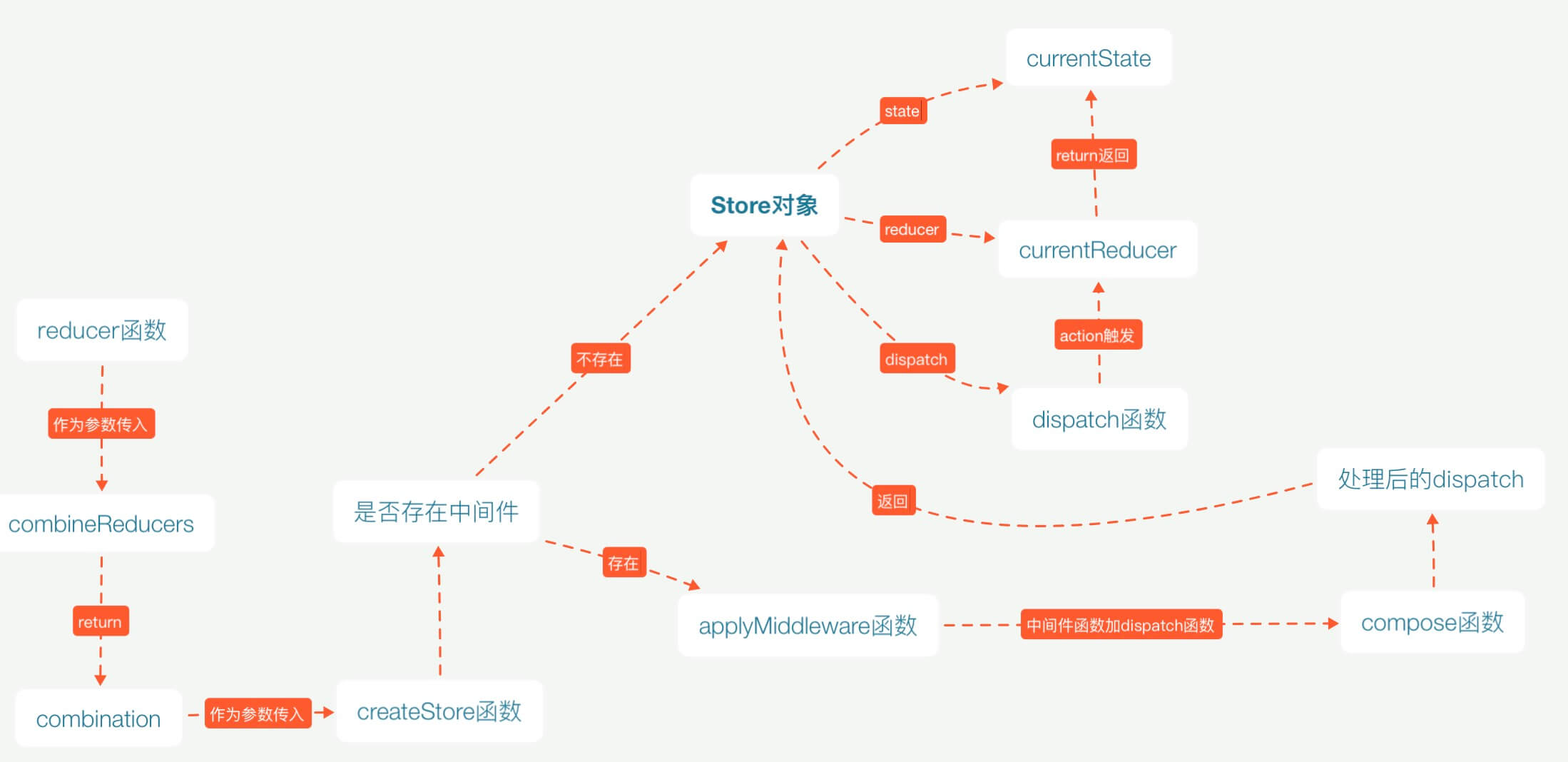# redux原理解析
作者: HerryLo (opens new window)
本文永久有效链接: https://github.com/AttemptWeb...... (opens new window)
Redux是JavaScript状态容器,提供可预测化的状态管理。下面的内容根据最新版redux@4.0.4,后期如果变动,可对照参考
在实际开发中,常搭配React + React-redux使用。这代表了目前前端开发的一个基本理念,数据和视图的分离。
redux应运而生,当然还有其他的一些状态管理库,如Flux、Elm等,当然,我们这里只对redux进行解析。
# redux创建Store
创建redux的store对象,需要调用combineReducers和createStore函数,下面解释不包含中间件。
const reducer = combineReducers({
home: homeNumber,
number: addNumber
})
const store = createStore(reducer)
// 暂时挂载在window下,下面会使用到
window.$reduxStore = store
2
3
4
5
6
7
# combineReducers函数
首先调用combineReducers函数,将多个reducer函数作为参数传入,源码如下:
// reducers即是传入的参数对象
function combineReducers(reducers) {
// ......省略
return function combination(state = {}, action) {
let hasChanged = false
const nextState = {}
for (let i = 0; i < finalReducerKeys.length; i++) {
// finalReducerKeys 是传入reducers对象的key值
const key = finalReducerKeys[i]
// finalReducers 等价于 reducers
const reducer = finalReducers[key]
const previousStateForKey = state[key]
// 运行reducer函数,返回一个state
// 核心:调用combination函数,实际就是循环调用传入的reducer函数
const nextStateForKey = reducer(previousStateForKey, action)
nextState[key] = nextStateForKey
// hasChanged = hasChanged || nextStateForKey !== previousStateForKey
}
// hasChanged = hasChanged || finalReducerKeys.length !== Object.keys(state).length
// 返回state对象
return nextState
}
}
// 源码地址:https://github.com/reduxjs/redux/blob/master/src/combineReducers.ts#L139
2
3
4
5
6
7
8
9
10
11
12
13
14
15
16
17
18
19
20
21
22
23
24
25
上面的代码其实非常简单,combineReducers函数运行,返回一个新的combination函数。combination函数的主要作用是返回一个挂载全部state的对象。 当combination函数被调用时,实际就是循环调用传入的reducer函数,返回state对象。将combination函数作为参数传入到createStore函数中。
# createStore函数
function createStore(reducer, preloadedState, enhancer) {
// reducer --> combination函数
let currentReducer = reducer
// 全部的state属性,挂载在currentState上
let currentState = preloadedState
// 下面的中间件会用到
if (typeof preloadedState === 'function' && typeof enhancer === 'undefined') {
// 第二个参数是一个函数,没有第三个参数的情况
enhancer = preloadedState
// 将preloadedState重置
preloadedState = undefined
}
if (typeof enhancer !== 'undefined') {
// 存在中间件时,将createStore传入中间件函数,调用enhancer函数,return结束。
return enhancer(createStore)(reducer, preloadedState)
}
function dispatch(action) {
// currentReducer --> combination函数
currentState = currentReducer(currentState, action)
}
// 初始化调用dispatch,创建初始state
dispatch({ type: ActionTypes.INIT })
const store = ({
dispatch: dispatch,
subscribe,s
getState,
replaceReducer,
[$$observable]: observable
}
return store
}
// 源码地址:https://github.com/reduxjs/redux/blob/master/src/createStore.ts#L60
2
3
4
5
6
7
8
9
10
11
12
13
14
15
16
17
18
19
20
21
22
23
24
25
26
27
28
29
30
31
32
33
34
35
36
reducer就是传入的combination函数,preloadedState是初始化的state(没有太大的作用),enhancer是中间件,没有第三个参数enhancer的情况下,同时第二个参数preloadedState是一个函数,preloadedState被赋值给enhancer。
调用dispatch函数初始化,currentReducer即是传入combination函数,就向上文提到的,调用combination函数实际就是循环调用reducer函数。所有的state对象,被挂载在内部变量currentState上。存在中间件enhancer时,将createStore传入中间件函数,调用enhancer函数,return结束,这个下文会继续讲到。
创建的store对象,暴露出的方法如下:
const store = ({
// 分发 action,这是触发 state 变化的惟一途径。
dispatch: dispatch as Dispatch<A>,
// 变化监听器
subscribe,
// 获取store下的 全部state
getState,
// 替换 store 当前用来计算 state 的 reducer
replaceReducer
}
return store
2
3
4
5
6
7
8
9
10
11
dispatch函数触发action,调用reducer函数,修改state。subscribe函数可以监听变化state的变化。getState函数获取全部state。replaceReducer函数替换用来计算state的reducer函数。
通过combineReducers函数合并reducer函数,返回一个新的函数combination(这个函数负责循环遍历运行reducer函数,返回全部state)。将这个新函数作为参数传入createStore函数,函数内部通过dispatch,初始化运行传入的combination,state生成,返回store对象

# redux中间件
最好把上面看懂之后,再看中间件部分!!下面对中间件进行分析:
redux-thunk只是redux中间件的一种,也是比较常见的中间件。redux-thunk库允许你编写与store交互的异步逻辑。
import thunkMiddleware from 'redux-thunk'
const reducer = combineReducers({
home: homeNumber,
number: addNumber
})
const store = createStore(
reducer,
applyMiddleware(
thunkMiddleware, // 异步支持
)
)
2
3
4
5
6
7
8
9
10
11
12
createStore函数支持三个参数,如果第二个参数preloadedState是一个函数,而没有第三个参数enhancer的话,preloadedState会被赋值给enhancer。
下面会以redux-thunk中间件作为例子,下面就是thunkMiddleware函数的代码:
// 部分转为ES5代码,运行middleware函数会返回一个新的函数,如下:
return ({ dispatch, getState }) => {
// next实际就是传入的dispatch
return function (next) {
return function (action) {
// redux-thunk核心
if (typeof action === 'function') {
return action(dispatch, getState, extraArgument);
}
return next(action);
};
};
}
// 源码地址:https://github.com/reduxjs/redux-thunk/blob/master/src/index.js
2
3
4
5
6
7
8
9
10
11
12
13
14
redux-thunk库内部源码非常的简单,github: redux-thunk 源码 (opens new window),允许action是一个函数,同时支持参数传递,否则调用方法不变。
# applyMiddleware函数
// 中间件调用
return enhancer(createStore)(reducer, preloadedState)
等价于
return applyMiddleware(
thunkMiddleware,
)(createStore)(reducer, preloadedState)
2
3
4
5
6
7
8
redux的中间件,从applyMiddleware函数开始,它主要的目的就是为了处理store的dispatch函数。
// 支持多个中间件传入
export default function applyMiddleware(...middlewares) {
return (createStore) => (reducer, ...args) => {
// 创建 store
const store = createStore(reducer, ...args)
const middlewareAPI = {
getState: store.getState,
dispatch: (action, ...args) => dispatch(action, ...args)
}
// 遍历运行中间件函数,将middlewareAPI作为参数传入
// middleware对应上面的redux-thunk库核心代码,当然也支持多个中间件
const chain = middlewares.map(middleware => middleware(middlewareAPI))
// 核心:将所有中间件传入到compose中,返回一个新的dispatch
dispatch = compose(...chain)(store.dispatch)
// 照常返回一个store对象,dispatch已经被处理过了
return {
...store,
dispatch
}
}
}
// 源码地址:https://github.com/reduxjs/redux/blob/master/src/applyMiddleware.ts#L55
2
3
4
5
6
7
8
9
10
11
12
13
14
15
16
17
18
19
20
21
22
23
applyMiddleware函数接收多个middlewares参数,返回一个store对象。通过createStore创建store对象,middlewareAPI对象挂载getState和dispatch,循环middlewares中间件,将middlewareAPI作为参数传入每个中间件。遍历结束以后,拿到了一个包含所有中间件新返回函数的一个数组,将其赋值给变量chain。
// 遍历之后chain的值,这里只是拿redux-thunk库作为例子
// next 就是 dispatch
chain = [function (next) {
return function (action) {
if (typeof action === 'function') { // redux-thunk核心
return action(dispatch, getState, extraArgument);
}
return next(action);
};
}, ...更多中间件]
2
3
4
5
6
7
8
9
10
# compose函数
// 数组chain 保存所有中间件新返回函数
dispatch = compose(...chain)(store.dispatch)
2
compose的主要作用就是遍历所有中间件函数后,将其聚合返回一个单一的dispatch函数。
// compose函数
return chain.reduce((a, b) =>{
return (...args)=> {
return a(b(...args))
}
}
2
3
4
5
6
chain是保存中间件函数的数组,具体的内部结构参见上面👆,下面来分析一下compose函数的调用逻辑。
// chain 类比为 [fn1, fn2, fn3, fn4]
[fn1, fn2, fn3, fn4].reduce((a, b) =>{
return (...args)=> {
return a(b(...args))
}
}
2
3
4
5
6
调用过程如下:
| 循环 | a值 | b值 | 返回的值 |
|---|---|---|---|
| 第一轮循环 | fn1 | fn2 | (...args)=> fn1(fn2(...args)) |
| 第二轮循环 | (...args)=> fn1(fn2(...args)) | fn3 | (...args)=> fn1(fn2(fn3(...args))) |
| 第三轮循环 | (...args)=> fn1(fn2(fn3(...args))) | fn4 | (...args)=> fn1(fn2(fn3(fn4(...args)))) |
经过 compose 处理过之后, 最后的返回值就是 (...args) => fn1(fn2(fn3(fn4(...args)))),这个的arg就是 store.dispatch函数。最后将返回函数赋值给dispatch,就是我们需要的dispatch函数了。而如果只有一个中间件的话,就会直接返回了。
applyMiddleware函数中间件的主要目的就是修改dispatch函数,返回经过中间件处理的新的dispatch函数

# redux使用
这里的使用是不配合react-redux+react的;
window.$reduxStore = store
store.dispatch(action);
let { aState } = store.getState()
2
3
4
5
上面是直接将其挂载在window对象之下,这样可以配合任何前端框架使用,当然这样肯定是不优雅的,后面我再会专门讲一篇配合react-redux使用的;
在这里调用store.dispatch函数,实际就是再次调用循环遍历调用reducer函数,更新之后被保存在createStore函数的内部变量currentState上。通过store.getState函数,返回currentState变量,即可得到所有state。
# 结束:
内容有点多,需要总结一下
1.redux创建Store:通过combineReducers函数合并reducer函数,返回一个新的函数combination(这个函数负责循环遍历运行reducer函数,返回全部state)。将这个新函数作为参数传入createStore函数,函数内部通过dispatch,初始化运行传入的combination,state生成,返回store对象。
2.redux中间件:applyMiddleware函数中间件的主要目的就是修改dispatch函数,返回经过中间件处理的新的dispatch函数
3.redux使用:实际就是再次调用循环遍历调用reducer函数,更新state
解析到这里就结束了,redux真的非常函数化,满满的函数式编程的思想,非常的模块化,具有很强的通用性,觉得非常赞👍👍
ps: 微信公众号:Yopai,有兴趣的可以关注,每周不定期更新,分享可以增加世界的快乐

武汉工作,会点Web,擅长Javascript.
技术或工作问题交流,可联系微信:1169170165.






